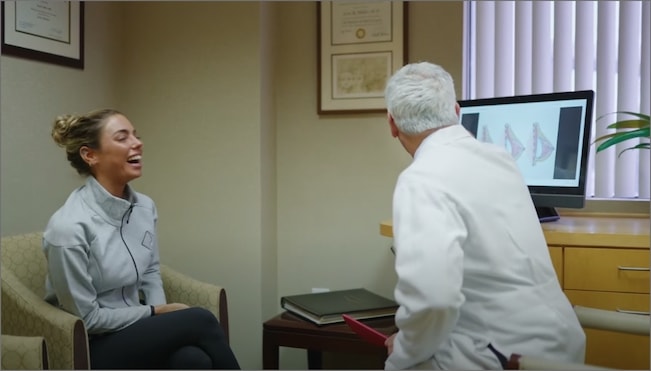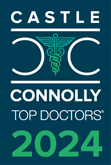Breast Augmentation & Implants
Breast augmentation is performed to add volume and fullness to the breasts through placement of implants. This can enhance or rejuvenate the shape and contours of the breasts while providing a curvier silhouette. Whether you are unhappy with the size of your breasts, you have experienced a loss of volume after pregnancy, or you would simply like to attain a better fit in clothing, breast augmentation is known for its exceptional results. As one of the most frequently performed plastic surgery procedures available, breast augmentation has helped countless women enhance their breasts and their confidence.
In your consultation, board-certified plastic surgeon Dr. Scott Miller will listen to your aesthetic goals and address any questions or concerns you may have about breast augmentation. His goal is to help you understand the pros and cons of the procedure, as well as how breast surgery will affect your body. Dr. Miller will explain your options regarding how the surgery is performed, including details about incision location, breast implant types, and the implant location. When necessary, a breast lift can be performed in tandem with breast augmentation. In any case, breast augmentation is fully customized to your individual needs to help you achieve naturally beautiful results.
Quick Facts About Breast Augmentation & Implants
- Procedure:
- Outpatient
- Length of Surgery:
- 1 – 2 hours
- Anesthesia:
- General
- Recovery:
- About one to two weeks
Explore Topics On This Page

Who is a Good Candidate for Breast Augmentation?
While breast augmentation is the premier solution to enhance the size, shape and volume of the breasts, the procedure can also offer a myriad of additional benefits for patients who would like to:
- Correct asymmetry issues and achieve a more balanced appearance
- Attain a rounder, more rejuvenated breast shape
- Restore the volume and contours often lost due to pregnancy, weight loss, and/or breastfeeding
- Reposition/resize the nipples and areolas
- Achieve a better fit for clothing and swimwear
- Enhance confidence and improve body image
Breast augmentation is most successful for women whose aesthetic goals align with the list above. It’s also important for patients considering breast surgery to be relatively healthy and have no uncontrolled or significant medical conditions.
“Good plastic surgery doesn’t leave you looking plastic. It enhances your looks naturally, and the improvement is often attributed to a vacation, new diet, or exercise regime.”
How is Breast Augmentation Surgery Performed?
The best approach for each patient depends on their unique needs and goals. This will be discussed during the consultation process. Once the incision has been made in the planned area, a pocket is then created either directly under the tissue or underneath the muscle. Breast implant sizers are placed and filled with air. This allows the patient’s size and shape to be evaluated and compared to presurgical goals before choosing the final implant. Then, the chosen implants are placed inside the pocket and the incisions are closed in layers, providing support to the outer incision and allowing for minimal scarring. Throughout the entire procedure, Dr. Miller pays close attention to aesthetic details, including symmetry, shape, and the natural contours of the body, in order to achieve naturally beautiful results.
Periareolar Breast Augmentation
Periareolar breast augmentation is an ideal approach to minimizing scarring as much as possible. The incision is placed along the lower portion of the areola, at the natural change in pigmentation between the breast skin and the nipple-areolar complex. Since incisions are well-concealed along the perimeter of the areolas, results can be exceptionally natural. Periareolar breast augmentation also allows for the best view of the breast tissue and musculature, allowing the most surgical control of the outcome. By placing the incision on the lower part of the areola, the surgeon can avoid the milk ducts and the main nerve of the breast proving the best chance to maintain breastfeeding ability and nipple sensation.
Inframammary Breast Augmentation
With the inframammary technique, the incision is made along a small portion of the inframammary fold (the breast crease) to camouflage scarring within the natural fold of the lower breasts. An inframammary incision offers good results with silicone and larger-sized implants, and the post-op scar is often well-hidden along the natural contours of the breasts.
Transaxillary Breast Augmentation
The transaxillary incision is made within a fold of the underarm, while this avoids incisions on the breasts, it is not an optimal technique. Dr. Miller does not perform this technique, as it offers no visibility and little access for implant placement. There are also limitations regarding the size and type of implant that can be placed with a transaxillary incision — the procedure is often only performed for saline implants, which are placed and then filled after insertion. This technique also voids the implant warranty.
Choosing the Right Incision for Your Needs
Discussing your hopes for the outcome with Dr. Miller will be very illuminating in helping you understand the right breast augmentation technique to make your goals a reality. There are several factors that influence which incision type will be the most ideal approach for your procedure, including:
- The size and type of implants you choose
- Your desires and preferences with regard to scarring
- Your natural anatomy and existing breast tissue
Dr. Miller will answer all of your questions and help guide you in the decision-making process, so you’re empowered to make the best choices for your goals.
Additional Breast Augmentation FAQs
Is Non-Surgical Breast Augmentation Possible?
While we strive to provide San Diego patients with a range of treatment options to achieve their goals, there is currently no reliable technique to augment the breasts without surgery. Implants have the unique ability to refine the size, volume, symmetry, and shape of the breasts according to each person’s ideal results — this cannot be replicated with any minimally invasive treatment.
Is Breast Augmentation Safe?
Breast augmentation is one of the most thoroughly researched cosmetic procedures available; therefore, surgery is considered very safe and effective when performed by a plastic surgeon accredited by the American Board of Plastic Surgery (ABPS). With a board-certified plastic surgeon, you can feel confident knowing you’re under the care of a breast surgeon who has completed extensive post-graduate training. Board-certification is only awarded to doctors who have undergone continuing education courses in aesthetic surgery, and who maintain a comprehensive level of clinical experience. Not only is Dr. Miller board-certified, but he is also fellowship-trained in aesthetic surgery. This means Dr. Miller has completed the highest caliber of training possible with aesthetic procedures, making him well-equipped to provide the safety, quality, and expertise that all breast augmentation patients deserve.
To maximize the safety of your breast augmentation procedure, we encourage you to ask your plastic surgeon the following questions during your consultation:
- Do you frequently perform breast augmentation?
- Do you have privileges to perform this procedure in a hospital?
- How many breast augmentations do you perform per year?
- Can I see before-and-after photos from previous patients?
- Are you board-certified by the American Board of Plastic Surgery?
- Do you belong to any professional organizations?
- Are you involved in breast augmentation research?
- Am I a good candidate for treatment?
What is Recovery from Breast Augmentation Like?
After breast augmentation, you will receive medications to help manage swelling and reduce discomfort. Soreness and general weakness is normal for the first two to three days of recovery, but you should feel stronger as the healing process progresses. Other common reactions after surgery include swelling, tenderness, and bruising, but these feelings should gradually subside over the course of your recovery. Most patients are up and about one to two days after their procedure and light ambulation (standing, light walks, moving around the house, etc.) is encouraged. Exercise and heavy lifting should be avoided until six weeks after breast augmentation.
Patients often return to work four to five days after their breast augmentation, provided their jobs are not physically strenuous. Some degree of firmness and/or changes in nipple sensation are normal right after surgery, but the breasts will soften and regain sensitivity over time. Sutures are removed about one week after the procedure. Dr. Miller and his team will give you detailed post-operative instructions and closely monitor your recovery in follow-up appointments.
How Long Does Breast Augmentation Last?
Implants generally don’t need to be replaced. If a patient's breast change with age, pregnancy, weight loss or gain and she is no longer happy with how her breasts look, or if a complication such as rippling, rupture, or capsular contracture (the hardening of scar tissue around the implant) occurs she may decide to have another surgery to regain the breast shape she desires. In these cases, a breast revision procedure can allow patients to change their implant type, shape, or size, or remove their breast implants altogether. If you wish to remove your implants without replacing them, a breast lift may be necessary to address stretched breast skin as well as restore the breasts’ former shape. Every breast augmentation patient experiences a different lifespan for their implants. However, there is usually no need to exchange implants unless it is an individual’s personal preference or clinical problems are experienced. Periodic (10-15 years post surgery) MRIs are recommended to monitor the condition of silicone or silicone gel implants, as both implant types are designed to keep their shape in the rare event of rupture.
Will I Have Breast Augmentation Scars?
Every surgical procedure will result in some degree of scarring; however, it is typical for scars to fade and gradually become more and more indistinguishable over time. Scars from breast augmentation are very discreet and hidden within the natural contours of the breast skin. The shape, size, and location of your scars will depend on which incision is used to place your implants. A periareolar incision is the most common technique, and allows resulting scars to blend well into the areola region’s change in pigmentation once incisions are fully healed. The inframammary incision is also a common technique that allows the incision to be hidden within the breast fold. Lastly, the transaxillary approach is a much less common and rarely utilized approach, where incisions are made in the armpit. You can diminish the prominence of any scars with the medical-grade skincare products offered at our San Diego practice. Dr. Miller or one of our experienced staff can suggest the best formulation for your unique skin type to encourage the fading of surgical scars if needed.
What is Capsular Contracture?
Capsular contracture refers to hardened scar tissue around your breast implants. The formation of some scar tissue around implants is normal and not a cause for concern alone, but some patients can experience abnormal tightness, swelling, and general discomfort when the scar capsule hardens and squeezes the breasts. This may also cause the breasts to change shape or appear higher on the chest wall. Dr. Miller takes every precaution during surgery to minimize the chance of capsular contracture. If this occurs, capsular contracture can be addressed through breast revision surgery. If you’re experiencing uncomfortable symptoms or notice changes in the way your breasts look/feel, you should contact the office for an evaluation.
How Do I Sleep After Breast Augmentation?
Dr. Miller will instruct you to sleep on your back after breast augmentation to avoid disrupting your implants and incisions. This is necessary during the initial recovery process. Propping up pillows can help prevent you from unintentionally rolling on your sides or stomach during the night.
What’s the Best Post-Op Breast Augmentation Bra?
A surgical bra with wide, comfortable straps and a front-facing closure is the best option to protect your incisions, reduce swelling, and support your new breast contours. You will be instructed to avoid wearing underwire bras for at least six weeks after your procedure. During your first follow-up appointment, your surgical dressing will be removed and you will be placed in your post-surgery bra. This should be worn, day and night, for six weeks after your surgery.
How Long After Breast Augmentation Can I Swim?
We instruct patients to wait at least six weeks after their breast augmentation before submerging their breasts in any kind of water. Showering is fine; however, swimming pools, jacuzzis, bathtubs, and ocean water should all be avoided above the waist. Making sure your incisions (and body) are fully healed before attempting any cardio activities or weight lifting is key to preventing complications and infections, as well as maximizing your results. You will receive detailed instructions on activity restrictions after your surgery.
Can I Breastfeed with Breast Implants?
By placing the incision along the bottom edge of the areola, Dr. Miller is able to avoid the milk ducts and the main nerve to the nipple, offering the greatest chance of maintaining breastfeeding ability with ease. The vast majority of patients who receive breast augmentation maintain breastfeeding function. However, there is always the possibility of difficulty with breastfeeding for a woman, even if she has not had breast augmentation. Also to note, with age and pregnancy, breastfeeding after the procedure will likely affect the volume and shape of the breasts, potentially changing the long term outcome of your breast augmentation and possibly creating the need for a secondary treatment in the future.













